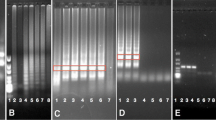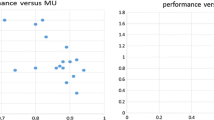Abstract
Specific legislation in the EU requires that foods containing more than 0.9% of genetically modified organisms (GMOs) should be labelled. To this end, we have developed a robust, quantitative, sensitive, nine-plex ligation-dependent probe amplification method, GMO-MLPA, for event-specific detection of maize TC1507, MON810, NK603, MON863, BT176, T25, GA21, construct-specific detection of BT11, and detection of the endogenous hmga maize reference gene. Ligated probes are amplified by PCR. Amplicons are detected using capillary electrophoresis. Specific GMO signals are normalised relative to the signal from the endogenous hmga gene and quantified by comparing with known standard curves. The method is suitable for quantification in the 0–2% range. Agreement was obtained in 149 of 160 determinations when 11 known mixtures of GMO and 9 food and feed samples were analysed using the GMO-MLPA method and compared to results from quantitative real-time 5′-nuclease PCR. The presented method is, therefore, suitable for quantification purposes for food and feed containing the most common maize GMOs.




Similar content being viewed by others
References
James C (2009) ISAAA brief no. 39
Marmiroli N, Maestri E, Gulli M, Malcevschi A, Peano C, Bordoni R, De Bellis G (2008) Anal Bioanal Chem 392:369–384
Grothaus GD, Bandla M, Currier T, Giroux R, Jenkins GR, Lipp M, Shan GM, Stave JW, Pantella V (2006) J AOAC Int 89:913–928
Asensio L, Gonzalez I, Garcia T, Martin R (2008) Food Control 19:1–8
Elenis DS, Kalogianni DP, Glynou K, Ioannou PC, Christopoulos TK (2008) Anal Bioanal Chem 392:347–354
Morisset D, Stebih D, Cankar K, Zel J, Gruden K (2008) Eur Food Res Technol 227:1287–1297
Holst-Jensen A (2007) Food toxicant analysis. Techniques, strategies and developments. Elsevier, The Netherlands, pp 231–268
Heide BR, Heir E, Holck A (2008) Eur Food Res Technol 227:527–535
Rudi K, Rud I, Holck A (2003) Nucl Acids Res 31:e62
Heide BR, Dromtorp SM, Rudi K, Heir E, Holck A (2008) Eur Food Res Technol 227:1125–1137
Cao WG (2004) Trends Biotechnol 22:38–44
Mano J, Oguchi T, Akiyama H, Teshima R, Hino A, Furui S, Kitta K (2009) J Agric Food Chem 57:2640–2646
Peano C, Bordoni R, Gulli M, Mezzelani A, Samson MC, De Bellis G, Marmiroli N (2005) Anal Biochem 346:90–100
Moreano F, Ehlert A, Busch U, Engel KH (2006) Eur Food Res Technol 222:479–485
Schouten JP, McElgunn CJ, Waaijer R, Zwijnenburg D, Diepvens F, Pals G (2002) Nucl Acids Res 30:e57
Ehlert A, Moreano F, Busch U, Engel KH (2008) Eur Food Res Technol 227:805–812
Delseny M, Glaszmann JC (1995) Biofutur 146:52–56
Acknowledgments
This work was financially supported by the European Commission through the Sixth Framework Program, integrated project Co-Extra (http://www.coextra.eu; contract FOOD-2005-CT-007158) and Norwegian Research Council project 154254/130.
Author information
Authors and Affiliations
Corresponding author
Rights and permissions
About this article
Cite this article
Holck, A.L., Drømtorp, S.M. & Heir, E. Quantitative, multiplex ligation-dependent probe amplification for the determination of eight genetically modified maize events. Eur Food Res Technol 230, 185–194 (2009). https://doi.org/10.1007/s00217-009-1155-4
Received:
Revised:
Accepted:
Published:
Issue Date:
DOI: https://doi.org/10.1007/s00217-009-1155-4




